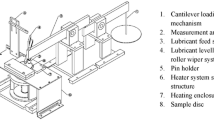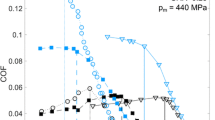Abstract
One of the considered research paths to reduce friction loss consists in optimizing the interactions between surfaces and lubricants. The latter may significantly change with the lubricant ageing. In this framework, the tribological behaviour of aged formulated lubricant is analysed for various low-speed reciprocating motions and with different nature of surfaces. This paper focuses on soot aggregate formation processes in a lubricated contact and on their correlation to friction. Although no aggregates have been observed in pure rolling conditions, pure sliding conditions may lead to the appearance of aggregates moving through the contact as a function of the nature of the surfaces. The analysis of their displacement within the contact is used to discuss their interactions with the surfaces. Moreover, we show that the velocity and the dwell time of the aggregate depend on the sliding speed. The morphology of these aggregates evolves over time, affecting friction behaviour. An additive law combining a contribution from the shear of the aggregates with another one due to the shear of a thin lubricant film surrounding the aggregate is then proposed to interpret friction origin and friction evolution with time of shear. The aggregate motion also varies with the nature of the surfaces: in particular, DLC–DLC couple reduces aggregation phenomena and maintains a low friction without apparent wear.












Similar content being viewed by others
References
Zheng, M., Reader, G.T., Hawley, J.G.: Diesel engine exhaust gas recirculation—a review on advanced and novel concepts. Energy Convers. Manag. 45, 883–900 (2004)
Sun, R., Kittelson, D.B., Blackshear, P.L.: Size Distribution of Diesel Soot in the Lubricating Oil. SAE Tech. Paper No. 912344 (1991)
Van Setten, B.A.A.L., Makkee, M., Moulijn, J.A.: Science and technology of catalytic diesel particulate filters. Sci Eng 43, 489–564 (2001)
Howard, J.B., Kaush Jr, W.J.: Soot control by fuel additives. Energy Combust. Sci 6, 263–270 (1980)
La Rocca, A., Di Liberto, G., Shayler, P.J., Fay, M.W.: The nanostructure of soot-in-oil particles and agglomerates from an automotive diesel engine. Trib. Inter. 61, 80–87 (2013)
Azambre, B., Collura, S., Trichard, J.M., Weber, J.V.: Nature and thermal stability of adsorbed intermediates formed during the reaction of diesel soot with nitrogen dioxide. Surf. Sci. 253, 2296–2303 (2006)
Kawamura, M., Ishiguro, T., Morimoto, H.: Electron microscopic observation of soots in used engine oils. Lubr. Eng. 43, 572–575 (1987)
Rounds, F.G.: Carbon, Cause of Diesel Engine Wear? SAE Tech. Paper No. 770829 (1977)
Colacicco, Ph, Mazuyer, D.: The role of soot aggregation on the lubrication of diesel engines. Trib. Trans. 38, 959–965 (1995)
George, S., Balla, S., Gautam, V., Gautam, M.: Effect of diesel soot on lubricant oil viscosity. Trib. Int. 40, 809–818 (2007)
Green, D.A., Lewis, R.: The effects of soot-contaminated engine oil on wear and friction: a review. Proc. IMechE 222, Part D: J. Automobile Engineering, 1669–1689 (2008)
Esangbedo, C., Boehman, A.L., Perez, J.M.: Characteristics of diesel engine soot that lead to excessive oil thickening. Trib. Inter. 47, 194–203 (2012)
Yoshida, K., Sakurai, T.: Mechanisms of valve train wear caused by diesel soot. J JSLE Int Ed 10, 133–138 (1989)
Meunier, C., Mazuyer, D., Vergne, Ph, El Fassi, M., Obiols, J.: Correlation between the film forming ability and rheological properties of new and aged low sulfated ash, phosphorus and sulfur automotive lubricants. Trib. Trans. 52, 501–510 (2009)
Varenne, E.: Usure de la distribution d’un moteur diesel. PhD thesis, École Centrale de Lyon (1996)
Bezot, P., Hesse-Bezot, C., Diraison, C.: Aggregation kinetics of colloidal suspensions of engine soots. Influence of polymeric lubricant additives. Carbon 35, 53–60 (1997)
Israelachvili, J.: Intermolecular and surface forces, 2nd edn. Academic Press, London (1991)
Chinas-Castillo, F., Spikes, H.A.: The behavior of diluted sooted oils in lubricated contacts. Tribol. Lett. 16, 317–322 (2004)
Liu, C., Nemoto, S., Ogano, S.: Effect of soot properties in diesel engine oils on frictional characteristics. Trib. Trans. 46(1), 12–18 (2003)
Green, D.A., Lewis, R.: Effect of soot on oil properties and wear of engine components. J. Phys. D Appl. Phys. 40, 5488–5501 (2007)
Hu, E., Hu, X., Liu, T., Fang, L., Dearn, K.D., Xu, H.: The role of soots particles in the tribological behavior of engine lubricating oils. Wear 304, 152–161 (2013)
Ratoi, M., Castle, R.C., Bovington, C.H., Spikes, H.A.: The influence of soot and dispersant on ZDDP film thickness and friction. Lubr. Sci. 17, 25–43 (2004)
Fujita, H., Spikes, H.A.: The influence of soot on lubricating films. Transient Process Tribol 43, 37–43 (2004)
Ray, S.K., Long, R.: Polycyclic aromatic hydrocarbons from diffusion flames and diesel engine combustion. Combust. Flame 8, 139 (1964)
Norman, G.R.: A New Approach to Diesel Smoke Suppression. SAE Paper 66-339 (1965)
Golothan, D.W.: Diesel Engine Exhaust Smoke: The Influence of Fuel Properties and the Effects of Using a Barium Containing Fuel Additive. SAE Paper No. 670092 (1967)
Miller, C.O.: Diesel Smoke Suppression by Fuel Additive Treatment. SAE Paper No. 670093 (1967)
Kim, K.B., Masiello, K.A., Hahn, D.W.: Reduction of soot emissions by iron pentacarbonyl in isooctane diffusion flames. Combust. Flame 154, 164–180 (2008)
Kasper, M., Sattler, K., Siegmann, K., Matter, U., Siegmann, H.C.: The influence of fuel additives on the formation of carbon during combustion. Aerosol Sci 30, 217–225 (1999)
Keskin, A., Gürü, M., Altıparmak, D.: Influence of metallic based fuel additives on performance and exhaust emissions of diesel engine. Energy Convers. Manag. 52, 60–65 (2011)
Covitch, M.: Oil Thickening in the Mack T-7 Engine Test. II—Effects of Fuel Composition on Soot Chemistry. SAE Tech. Paper No. 880259 (1988)
Holmberg, K., Andersson, P., Erdemir, A.: Global energy consumption due to friction in passenger cars. Trib. Inter. 47, 221–234 (2012)
Bou-Chakra, E., Cayer-Barrioz, J., Mazuyer, D., Jarnias, F., Bouffet, A.: A non-Newtonian model based on Ree-Eyring theory and surface effect to predict friction in elastohydrodynamic lubrication. Trib. Int. 43, 1674–1682 (2010)
Fay, H., Cayer-Barrioz, J., Mazuyer, D., Mondain-Monval, O., Ponsinet, V., Meeker, S.: Lubrication mechanisms of lamellar fatty acid fluids. Tribol. Lett. 46, 285–297 (2012)
Narita, K., Kakugawa, K., Miyaji, T.: Effects of Soot and Oil Additives on the Valve Train Wear of Diesel Engine. Inter. Tribol. Conf, Japan (1995)
Collins, I.R., Taylor, S.E.: The microstructural properties of coagulated nonaqueous carbon black dispersions. Inter. Sci. 155, 471–481 (1993)
Hamrock, B.J., Dowson, D.: Isothermal elastohydrodynamic lubrication of point contacts. NASA Tech. Notes D8318, 1–31 (1976)
Ayel, J.: Lubrification des groups motopropulseurs d’automobile. SIA, CLESIA (1995)
Höhn, B.R., Michaelis, K., Mann, U.: Film Thickness in Highly Loaded Contacts—Influence of Various Base Oils and VI-Improvers. SAE Technical Paper Series No. 961109 (1996)
Cross, M.M.: Polymer rheology: influence of molecular weight and polydispersity. J. Appl. Polym. Sci. 13, 765 (1969)
Guangteng, G., Spikes, H.A.: Boundary film formation by lubricant base fluids. Tribol. Trans. 39, 448–454 (1996)
Vaglieco, B.M., Beretta, F., D’Alessio, A.: In situ evaluation of the soot refractive index in the UV-visible from the measurement of the scattering and extinction coefficients in rich flames. Combus. Flame 79, 259–271 (1990)
Mullins, J., Williams, A.: The optical properties of soot: a comparison between experimental and theoretical values. Fuel 66, 277–280 (1987)
Chauveau, V., Mazuyer, D., Dassenoy, F.: In situ film-forming and friction-reduction mechanisms for carbon-nanotube dispersions in lubrication. Tribol. Lett. 47, 467–480 (2012)
Acknowledgments
The authors acknowledge IREIS Company (France) for active collaboration and fruitful discussions. The authors wish to express their appreciation to the Agence Nationale de la Recherche for partial funding via the ANR Project EcoLub 09-MAPR-0015.
Author information
Authors and Affiliations
Corresponding author
Rights and permissions
About this article
Cite this article
Ernesto, A., Mazuyer, D. & Cayer-Barrioz, J. The Combined Role of Soot Aggregation and Surface Effect on the Friction of a Lubricated Contact. Tribol Lett 55, 329–341 (2014). https://doi.org/10.1007/s11249-014-0365-5
Received:
Accepted:
Published:
Issue Date:
DOI: https://doi.org/10.1007/s11249-014-0365-5




